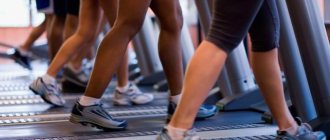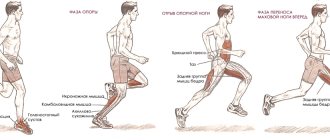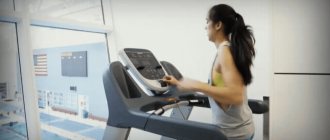When is it better to run in the morning or evening?
The research results confirmed that there is no significant difference between morning and evening running. The only difference is that exercising before starting work or school helps you wake up faster, and exercising at the end of the day relieves physical and mental stress and promotes quick relaxation.
It is recommended to select training times depending on your personal work or study schedule. Most athletes face the problem that it is difficult for them to devote at least 30 minutes to jogging every day.
This situation says only one thing - the class schedule does not take into account personal preferences and the characteristics of work or study.
When selecting training times, the following are taken into account:
- How the daily routine is structured. It is important to remember that you should create a sports schedule so that you have time to go for a run before or at the end of work or school and clean up after it, for example, take a shower.
- Features of the body. If a person goes to bed early and feels great in the morning, he will be more comfortable running before the start of the working day. For those who are considered so-called night owls, evening jogging is more suitable.
What are the running goals?
They begin to run, guided by various goals. For some, it’s strengthening the immune system, training the heart and endurance, a way to distract themselves and get unnecessary thoughts out of their heads. For others, it’s achieving a sports result or an option for morning exercises. But most people begin to engage in this sport with the goal of losing extra pounds.
Workouts for weight loss and weight loss
While running, the body burns calories and stored fat.
This helps you lose weight only if you do not compensate for this loss of calories by eating excess food. The best way to lose weight through exercise is a combination of exercise and a high-protein diet. If you have more than 30 kilograms of excess weight, high blood pressure or cardiovascular disease, then jogging is contraindicated.
General recommendations for training for weight loss:
- If you are overweight by 10-15 kilograms, start exercising with brisk walking and only after 2-3 sessions start jogging.
- When choosing a time for running, focus primarily on your biorhythms.
- If after a hard day you like to sit in front of the TV with a plate of something tasty, then it is better to choose evening hours for training. This will prevent you from over-absorbing unnecessary food.
Once you start exercising and get involved in a sports lifestyle, you will definitely notice the effect of losing weight.
Jogging is the most suitable option for the first months of training. But then there comes a period when your kilograms stop at the same level and do not want to fall further. The body adapts to constant physical activity and begins to consume energy more slowly. To achieve the desired weight, you should change your running tactics. At this point, your body is already sufficiently prepared for interval training. Start with a light jog. After 200 meters you accelerate to maximum speed. Gradually slow down and go into a light run or even a walk, depending on how you feel. After 5-10 minutes, repeat the cycle.
How to run to lose weight in your legs
Any jogging makes your legs slimmer.
The main load goes directly to the lower limbs, so the leg muscles are tightened first. Contracting fibers take energy from fat cells and thereby reduce their volume. In addition to regular workouts in the park or at the stadium, running up the stairs is considered effective for losing weight. It creates additional stress on the legs and increases the body's energy consumption.
Choose difficult trails, with numerous turns, descents, steps and ascents.
There are special leg weights, but this is an option for trained athletes. Adding stress to the legs doubles energy expenditure and stimulates the functioning of the heart and circulatory system.
Jogging to maintain muscles
To maintain fitness, it is recommended to jog for at least 1 hour.
Experts say that during exercise you need to know and feel which muscles are working. Then the training will become much more effective. The main load during exercise falls on the quadriceps, muscles of the buttocks and thighs. They train by walking up stairs, squats with barbells and dumbbells, and doing leg presses. Regular jogging keeps them fit perfectly.
The supporting function when running is performed by the biceps, neck muscles and abdominal muscles. They will also stay in good shape with regular jogging.
How to run correctly
Running technique, speed, pace
Coaches, answering the question of how to run correctly, always say that it all depends on what results a person wants to achieve. The length of the distance, speed, frequency of training and technique - all this is selected based on the goal set by the athlete.
Jogging helps:
- Strengthen the heart and blood vessels and increase lung capacity. To achieve this goal, long distance running at a calm pace is optimal, as well as interval training, in which the speed constantly changes throughout the run.
- Develop the muscles and joints of the legs (ankle, quadriceps, triceps femoris). Those who want to achieve this goal are advised to use the “Scissors” running technique - the foot begins to move backwards before it fully touches the ground, the push during such running becomes as strong as possible, since the back surface of the thigh is included in the work.
- Lose weight. Interval running for medium and short distances will help you get rid of extra pounds. The speed is selected depending on the weight, health and physical data (endurance, lung capacity, age) of the person.
Depending on your goal, doctors and trainers recommend choosing from the following types of training:
- Classic style - suitable for everyone, classes are held in a relaxed mode, the length of the distance is average or marathon. During such a run, the foot gently rolls from toe to heel, the body leans slightly forward, and the arms bend at the elbows.
- Shuttle run - develops joints and coordination of movements. The distance is from 10 to 100 m, poles are placed at the beginning and end. The athlete’s task is to reach the finish line as quickly as possible, perform a sharp turn and run to the start. The number of repetitions depends on the physical capabilities of the person.
- Sprint race – characterized by a short distance and maximum speed. Helps develop endurance and strengthen the heart.
Don't miss the most popular article in the section: Body drying for girls. Training program, detailed nutrition menu for the month by day.
How much should you run per day?
The duration of the run depends on the person’s fitness level and the chosen style.
Beginners using the classic type of exercise are recommended to run from 15 to 30 minutes; more trained athletes can extend the workout to 45-60 minutes. A sprint race usually lasts from 15 to 25 minutes, exactly the same as a shuttle race.
It is important to remember that you need to add 10-15 minutes to the specified time; they are necessary for warming up and stretching.
How to start running correctly
Beginning athletes learning the basics of how to run properly should begin training with preparatory exercises. This will prevent damage to the ankle joint and help you master the classic foot placement.
Before starting jogging, you need to roll your feet alternately from toe to heel for 10-15 minutes at home for 3-5 days. It is advisable to do the exercise in the sneakers that will be used during training.
The benefits of running in the morning
Beginning runners are advised to choose the first half of the day for training. This makes it much easier to get used to regular exercise and not give it up. The likelihood that in the evening a person who is not in the habit of exercising, citing fatigue, will skip a lesson is much higher.
Another good thing about a morning run is that it helps you recharge your energy for the whole day.
How to force yourself to run in the morning
A few simple steps will help you find and maintain motivation for regular exercise:
- Write down what goals will be achieved after a month of training. For example, the list may include phrases such as “weight will decrease,” “sleep and appetite will improve,” “immunity will strengthen.”
- Ask your loved ones to monitor the regularity of your classes, remind you of your goals, and praise you for your successes.
- Find a group of like-minded people who want to learn how to run properly and train as a team.
Stretching before running
Trainers and doctors advise starting the session with a warm-up and some stretching, this will reduce the likelihood of injury.
Warm-up
You should walk vigorously for 1-3 minutes, raising your knees high and swinging your arms, then tilt your body forward, to the sides and back several times, this will prepare your back muscles for running.
Stretching
Next, do a little stretching; experts advise including the following exercises:
- Bend forward, during which a person tries to reach the ground with his hands. Knees should be straight, feet shoulder-width apart.
- Stretching the calf muscles. One leg is bent at the knee at a right angle, the second, straightened, is taken as far back as possible. The hands are fixed on the bent knee. The toe of the straight leg rests on the ground, and the tension in the lower leg muscles is felt. The position is fixed for 5-10 seconds.
Running for beginners. Training program
To understand what training schedule is considered correct and how long you need to run, you can use one of the standard programs. It is designed for beginners who have not previously practiced this sport.
| Running program for beginners | Men | Women | ||
| Duration of training (without warm-up and stretching) | 30 minutes | 25-30 minutes | ||
| Pace | Medium (breathing while running is calm, a person can carry on a conversation if necessary, but not for long) | Medium (breathing while running is calm, a person can carry on a conversation if necessary, but not for long) | ||
| Periodicity | Daily or with 2 days off | Mon - 2 minutes walk, 26 minutes run, 2 minutes walk. | Every day or every other day | Mon. – 4 minutes walk, 20 minutes run, 3 minutes walk. |
| Tue – 2 minutes walk, 27 minutes run, 1 minute walk. | Tue - 4 minutes walk, 20 minutes run, 3 minutes walk. (Can be replaced with 1 day of rest) | |||
| Wed. – 2 minutes walk, 27 minutes run, 1 minute walk. | Wed. - 4 minutes walk, 20 minutes run, 3 minutes walk. | |||
| Thurs. – 2 minutes walk, 27 minutes run, 1 minute walk. (Can be replaced by 1 day of rest) | Thurs. - 4 minutes walk, 20 minutes run, 3 minutes walk. (Can be replaced by 1 day of rest) | |||
| Fri. – 2 minutes walk, 27 minutes run, 1 minute walk. | Fri. - 4 minutes walk, 20 minutes run, 3 minutes walk. | |||
| Sat. – 2 minutes walk, 27 minutes run, 1 minute walk. | Sat. - 4 minutes walk, 20 minutes run, 3 minutes walk. (Can be replaced with a day of rest) | |||
| Sun. – 2 minutes walk, 27 minutes run, 1 minute walk. (Can be replaced with a day of rest) | Sun. - 4 minutes walk, 20 minutes run, 3 minutes walk. | |||
| Change of schedule | Each subsequent week, the running duration can be increased by 2-3 minutes. | Each subsequent week, the running duration can be increased by 1-3 minutes. | ||
How to breathe correctly
During training, breathing should be uneven (inhalation is longer than exhalation) and medium deep. Doctors recommend inhaling through your nose rather than through your mouth, otherwise you may experience a sore throat and discomfort.
It is important to know how to run and breathe correctly when running, so as not to accidentally cause harm to your health.
You can exhale through your mouth or nose, not sharply, but briefly. You should start jogging while inhaling; while walking (initial and final), follow the same breathing technique as when running.
How often should you run?
Doctors allow me to jog every day. But, according to research, you can lose weight or tone muscles faster if you take days off.
It is recommended to stick to a schedule of every other day for women and 2 workouts - 1 day of rest for men. It is allowed to replace 1 more run per week with intense walking of the same duration.
Training duration for men and women
The duration of training depends not only on a person’s gender, but also on his level of training. But there are also general recommendations from trainers, which read:
- Men who choose daily training in the classical style can exercise from 30 to 45 minutes.
- Men who choose classic-style training according to a schedule of 2 days of training and 1 day of rest can run from 35 to 60 minutes.
- Women who choose daily training in the classical style can exercise from 20 to 40 minutes.
- Women who choose classic-style training on a schedule every other day can exercise from 30 to 45 minutes.
Why you need to pay attention to your pulse
According to the recommendations of sports medicine specialists, running correctly without taking into account both heart rate and lung capacity will not work.
During training, it is necessary to either clearly monitor your heart rate, or focus on the so-called level of subjective tension (breathing comfort).
It’s impossible to run correctly without taking into account both heart rate intensity and lung capacity.
With moderate intensity training, the pulse will be from 93 to 118 beats per minute, breathing will be deep and even.
Doctors say that by monitoring heart rate and subjective tension, a person reduces the likelihood of injury and increases the duration of training.
By neglecting these rules, the athlete risks giving too much or, on the contrary, too little load. In the first case, problems with breathing and the condition of the heart muscle may arise; in the second, the results from training will be too insignificant.
When to run and how many times a week
The most important thing in running is to listen to your body. Try running in the morning, afternoon, evening. Decide when you feel most comfortable. Naturally, the experiment must be accompanied by a serious desire to start running in principle. Things won't work through force.
An outdated stereotype is the statement that you should run in the morning. Time is not critical. Remember that running immediately after sleep is not recommended. At least 20 minutes must pass for the body to tune in to active action.
It’s clear that running in the morning helps you wake up and gives you energy for the whole day. And in the evenings, oddly enough, on the contrary, it helps to fall asleep.
When choosing a time to run, follow these tips:
- You cannot run completely hungry and too full, that is, on a completely empty and on a full stomach.
- You should not drink a lot of water before running. It’s better to either take small sips as needed throughout the workout or drink after, but not in one gulp.
- Try not to run in rain or ice.
- It is also undesirable to run in severe frost. But if this is typical weather for your region, you have no choice - you have to run. Or you should prefer exercising on a treadmill in the gym.
- Postpone your workout if you are sick. Colds, malaise, fever. Any condition different from the norm is a contraindication.
- If you are hypertensive, measure your blood pressure before running. Do this after training as well. Then compare the results. This way you can determine the optimal jogging intensity for yourself. Large pressure surges should not be allowed.
You can run 3-6 times a week. Morning runs lasting 15–20 minutes can be done 6 times a week. If you exercise 3 times a week, extend your run to 30-40 minutes. Focus on these numbers if you want to run 4 or 5 times a week.
Is it possible to run during menstruation?
It all depends on the woman’s health and the individual characteristics of her body. If menstruation occurs without pain and with average intensity, and the woman does not have gynecological diseases or pathologies, doctors allow her to play sports.
The only thing that gynecologists warn about in this case is the need to reduce the time of exercise during menstruation.
Don’t miss the most popular article in the section: Glutamic acid - what it is, why and how it is used in sports and bodybuilding.
The benefits of running and its effect on weight loss
The process of losing weight is not just about eating right or exhausting diets. Only an integrated approach helps you lose weight and record the desired number on the scales. What does this complex consist of? This includes proper nutrition and exercise, proper sleep patterns and control of your emotions to avoid stress.
Sports can be different, and each person chooses the option that suits him either for health reasons or to his liking. Sports exercises can be divided into two categories: strength training and cardio . The former are aimed at building muscles and toning the body, while the latter are aimed at drying the body, that is, burning fat.
As a rule, both workouts are combined in one, but some exercises remain dominant. What does it mean? You can't do only cardio or only strength training. More precisely, you can just do cardio, but you will still have to stretch your muscles and perform a number of basic exercises.
The same applies to the forces. You'll need to warm up before doing this type of workout, and typically the first 10 minutes before a strength workout is cardio. And to consolidate the results at the end of classes, you should also do cardio for 15-20 minutes.
What is this cardio? Here are examples of cardio workouts that help dry out the body and burn excess fat:
- run;
- intense walking;
- a ride on the bicycle;
- roller skating;
- exercises on the ellipse;
- jumping rope;
- dancing;
- Zumba
Cardio training is important because it stimulates the heart and improves it. Cardio can also be called aerobics, just with a series of specific exercises. It’s impossible to say which cardio workout is considered the most popular, but according to surveys and statistics, many people believe that running is the most effective way.
Indeed, running practices are very useful not only for improving heart function and improving the respiratory system, but also for strengthening muscles and creating tone. Other benefits of running:
- strengthening heart function;
- normalizes hormonal levels;
- tightens the skin;
- improves digestion processes;
- improves the condition of the respiratory system;
- increases immunity;
- increases the tone of arterial vessels;
- stabilizes blood pressure.
Running has a direct impact on the process of losing weight, but you need to be able to run correctly, and in general, cardio training requires good preparation. You can’t just pick it up and start running right away. Have you noticed how you feel after suddenly running after a bus leaving a stop or walking up the stairs to your floor when the elevator breaks down?
Most people who do not or rarely exercise or have certain problems with the heart, blood pressure or blood vessels feel weak, short of breath and cannot recover for a long time after such sudden runs. This is because the heart needs to be trained, and that’s what cardio training is for.
Note! Running helps you lose weight with regular practice and if you do it correctly. During cardio, the fat burning process starts only 20-30, and sometimes 40 minutes after the start. Accordingly, it all depends on the specific type of cardio and the intensity with which you perform the activity.
Why is this so important and how should you actually run correctly? Below you will find answers to these questions.
How to learn to run fast
Before you start learning to run at maximum speed, you need to correctly draw up an endurance training schedule; the duration and intensity of the session depends on this indicator.
To do this, your heart rate is monitored throughout the week at the beginning, middle and end of the session. The pace at which the intensity of the load will be average, moderate is verified.
Next, the jogging schedule changes as follows - approximately every 8-12 minutes of training, you need to run 1-3 minutes at the maximum possible speed. After 1-2 weeks, the duration of high-intensity periods increases by 1-2 minutes.
How to choose a place to run?
When choosing a place to run, try to avoid frequently crossing the road, especially in places not marked for crossing. A useful addition would be the presence of natural barriers in the form of ascents and descents.
There are several options for where you can run.
Stadium. The most comfortable place for running training. The bases of the stadiums differ, but all have a place reserved for running, a flat surface and the presence of horizontal bars, parallel bars, stairs to complete the workout and stretch the muscles.
Parks. Convenient place for jogging. The parks feature a lot of trees and fresh air. The paths have a flat surface, which means you don’t have to worry about the possibility of an ankle sprain. People walking in the park are unlikely to become a serious nuisance.
Streets. Running along the city streets is a good option if the rest of the infrastructure is far away or does not meet the requirements for training. The downside is the high content of exhaust emissions in the air, because sidewalks are located along roadways. Otherwise, it’s just as suitable for jogging as a park.
Forest. The presence of natural barriers in the forest is a good incentive to train. Changing the surface topography in the form of sand, leaves and cones will allow you to train your overall endurance. Running through the forest is more difficult, but the number of calories burned is higher.
Who should not run?
Doctors identify the following diseases in which it is better to replace jogging with another sport:
- myopia and glaucoma;
- cardiovascular diseases;
- diseases of the respiratory system, asthma;
- joint diseases, arthritis.
It is not recommended to run during periods of exacerbation of chronic diseases and during colds, ARVI, and flu. People over 50 years of age who do not have a sports background and good health are advised to replace jogging with walking.
Correct running techniques
Running technique refers to a certain set of rules that must be followed when performing this type of movement. This will avoid possible injuries and fatigue, which will ultimately make the process more enjoyable and rewarding.
Proper breathing while running
While running, you need to breathe deeply and rhythmically, mainly through your nose.
If you are out of breath, taking shallow and quick breaths, it means the load is too great and you need to slow down. Try taking one breath for every two steps. If you are new to this sport, a lack of oxygen due to improper breathing combined with an untrained diaphragm may cause a tingling sensation in your side.
In such cases, the following is recommended:
- Slow down, but don't stop;
- Try breathing through your mouth;
- Take a deep breath and exhale slowly;
- If you have a tingling sensation in your left side, then as you exhale, step on your right foot, and vice versa.
How to choose running shoes for running
Running shoes are divided into two types - for training and for competitions.
Running shoes for training protect your feet from injury. Competition shoes are designed to help the athlete quickly gain speed and achieve a high tempo. For recreational running, training sneakers are used, the choice of which is very diverse. When purchasing sneakers, consider the following factors:
- When you run. Summer shoes are light, with good ventilation, but do not protect against moisture. Winter - waterproof and retains heat.
- Where do you plan to run? For hard surfaces such as asphalt, paving stones or stadium surfaces, asphalt shoes are suitable. If you are jogging on dirt or off-road, you must purchase shoes for rough terrain.
- How do you run? If you use a toe-heel or full-foot technique, buy shoes with a flatter sole and cushioning should be located in the front. For the heel-toe technique, the sole is made higher and the shock absorption is located in the heel area.
You can't choose running shoes based on performance alone. Any sneakers must be measured, since they differ in instep height, pronation, supination, last width and other criteria. The optimal size option is when the toe is 5 millimeters short of the inner front of the sneakers.
Popular brands:
- Adidas. They are distinguished by an ultra-breathable upper mesh, ventilation inserts in the sole, low weight, perforated insoles, and a flexible sole.
- Asics. The sneakers use high-strength rubber, gel shock-absorbing inserts, and a comfortable last.
- New Balance. Very soft, stable, with neutral shock absorption.
- Reebok Zquick. Excellent fixation of the foot, minimizing the risk of calluses, high adhesion of the sole to the surface.
- Mizuno. Modern shoes for professional sports.
How to start training
A common mistake new runners make is starting too quickly.
Gradually increase the load to a certain maximum; too frequent and intense exercise does not improve your health, but has the opposite effect. You need to start with the following steps:
- Clearly set a goal for yourself - to run, and be determined that this will last for a long time.
- Choose the right sneakers and sportswear.
- Determine your running location and route in advance.
- Avoid extremely hard or uneven surfaces, steep inclines and descents.
- Watch your pulse, it should be between 110-120 beats per minute.
How to warm up before running
Don't neglect warming up - it allows you to warm up your muscles and joints, prepare them for serious stress and fill them with oxygen even before the start of your workout.
A set of warm-up exercises for 10 minutes:
- Warm up your neck with circular movements of your head.
- Rotate your arms 3 times in one direction and the other.
- Lateral bends, body rotation.
- We warm up our legs: squats, running in place with the knee raised to 90 degrees, light jumping in place.
- Walk a few meters at an energetic pace and start jogging.
Running at a low pace
Start your training with this type of running.
It is considered easy, and the guideline for it is your sensations. If you can talk calmly while jogging, it means you are moving at a low pace. Such running allows you to train the beginner’s body for subsequent, heavier loads. Running at a low pace has the following effects: blood circulation improves, the musculoskeletal system is strengthened, and the heart muscle is trained. This type of running is a good prevention of cellular hypoxia.
Jogging
Jogging is jogging at a speed of 7-9 km/h, which is slightly faster than running at a low pace.
The following features are characteristic of jogging:
- The step length should not exceed 70-80 cm.
- The elbows are located close to the body.
- The body is kept in an upright position.
- The leg touches the surface with the entire foot at once, that is, the “whole foot” technique is used. A heel-toe option is also allowed.
- The emphasis is on long exhalation.
- The muscles of the shoulder girdle are relaxed.
- The arms are bent and working forward, the hands are collected.
Running for beginners
Running training for beginners largely depends on the degree of preparedness of the body for the load.
If you are an office worker and generally lead an inactive lifestyle, do not rush to increase your distance and speed up the pace. Basic recommendations for beginners:
- Exercise 3 times a week, every other day.
- To get started, try exercising for 20 minutes, including warming up and walking.
- Follow the technique of movement and breathing.
- Increase your speed only if the 15 minutes of your current run are effortless.
- Avoid jogging over rough terrain, give preference to stadiums and straight park paths.
- Land on your entire foot at once; this is the least traumatic form of running.
Most beginner runners make the following mistakes:
- Wrong sneakers and too warm clothes.
- Mistakes in nutrition - you can’t exercise either on an empty stomach or on a full stomach. An hour before training, it is recommended to have a light, healthy meal; do not overeat.
- If you are not overweight, do not get carried away with depreciation. Shoes that are too soft do not allow you to feel the movements of the foot, which can cause problems with your running technique.
- Train your back and abdominal muscles. They are just as important when running as strong legs. Do special exercises for these muscle groups at home or in the gym.
- Use a heart rate monitor - this will allow you to maintain the right pace, since the gadget tracks your heart rate and estimates the load on the heart while running.
- The attitude of a beginning runner is also very important - he must be positive and determined to achieve his goals.
How to run correctly
For running to become a guarantee of a healthy lifestyle, good health and mood for you, it is important to follow the basic rules.
Jogging from the “I run as I run” series is not suitable for achieving the required results. Running rules:
- Keep your head straight. Look straight ahead, 30-40 meters ahead. Don't run with your head down, looking at your sneakers. The neck and shoulders should be relaxed.
- Smoothly straighten your shin while moving your leg forward. Early extension of the lower leg leads to landing with the entire weight on the straightened leg, which affects the knee, hip joints and spine.
- Bend your elbows at an angle of 90 degrees. They should also be relaxed, the hands should be slightly compressed.
- Avoid slouching, as this makes breathing difficult and reduces oxygen supply. Shoulders should be pulled back and down. Keep them relaxed and avoid tension.
- Keep your upper body motionless relative to the vertical axis. Some experts recommend tilting your body a little forward, this reduces the load on the heel area and helps you land on your full foot.
- Neither the body nor the hips should sway from side to side.
- Don't raise your knees too high. They should move forward, not up.
- Steps should be light and quiet. Regardless of the type of running, you should not hit your feet hard on the surface. Running silently is one of the components of proper technique.
Watch your posture while running, after a few workouts you will get used to the correct body position and will maintain it automatically.
How useful it is to run
Many experts believe that the most useful form of running is jogging.
It is quite easy to perform, provides little stress on the joints, and does not cause fatigue. The benefits of light running are also confirmed by studies: mortality rates due to cardiovascular diseases among joggers were much lower than among fast runners and people leading a sedentary lifestyle. Easy running is less traumatic than fast running. If your goal is to improve your health and increase your life expectancy, then jogging is the best option.
What clothes are best for running?
For classes, you need to purchase shorts or sweatpants, a T-shirt or tank top (ordinary cotton one), a windbreaker, and running shoes. Women will also need to buy a special sports bra; training in regular everyday underwear will be uncomfortable.
If a person plans to run in winter, the equipment should be supplemented with a warm sports jacket with synthetic padding, a hat or knitted headband, and gloves.
Please note that it is also better to buy special socks, sold in sports stores; your feet will not rot in them, and the possibility of skin damage from friction will be eliminated.
The place where you will run
It is best if this place is a stadium or park. The stadium has a special covering for running tracks, and the park has a changing terrain, including ups and downs, which is important for an even load on all muscle groups.
You should try to avoid asphalt paths, as they increase the load on the spine. If you cannot avoid the asphalt, then you need to purchase running shoes with thick soles and good shock absorption so that the impact of your feet on the asphalt becomes weaker.
When choosing a location, you should also think about personal safety. For example, you should avoid places where packs of dogs are likely to appear. You should not run in areas intended for walking pets. You should not choose a running route that runs through deserted wastelands or similar places where you can easily become a victim of intruders. Also, do not run along the sides of roads, especially in the dark.
In order to check your route for safety, you should first simply walk along it. Firstly, you visually remember all the features of the terrain along which your route runs, and secondly, for beginners in running, walking is an excellent start to training.
For the first time, a 15-minute walk along the route is enough. The next time, you can increase the walking time to 20-30 minutes, then start mixing periods of walking with periods of running. After a couple of weeks, you can fully jog for 40–50 minutes. It is recommended to set aside three to four days a week for jogging.
The main rule is that the load should increase gradually.
A significant addition to your training will be a combination of straight sections with ups and downs on the route, so the training will be more effective.
How to properly run to lose weight
Trainers say that to lose weight, it is important not only to exercise regularly, but also to adhere to a diet at the same time. Otherwise, the extra pounds will not go away.
How much time a person exercises, whether he does it daily or whether his jogging schedule includes weekends - all this simply helps to create a calorie deficit and tighten muscles, that is, speed up the process of weight loss and gain beautiful body shape.
How much should you run to lose weight?
According to research by nutritionists, weight loss will begin from the first month of training. How quickly the kilograms will go away depends on the intensity of your exercise. It must be remembered that for a beginner, the load should be average, and not too high or too low.
The exact duration of the workout is less important than the regularity, but spending less than 20 minutes on sports activities is not recommended.
Approximate running table for women for a week
If you want to lose weight, you can use a ready-made program. It should be remembered that it is not suitable for people with severe obesity; they need to consult a nutritionist and sports doctor to develop an individual weight loss plan.
| First day | Moderate intensity running (heart rate 93 to 118 beats per minute) for 20 to 25 minutes |
| Second day | Moderate intensity running (heart rate 93 to 118 beats per minute) for 20 to 25 minutes |
| The third day | Rest day (can be replaced with moderate-intensity walking for 30 minutes) |
| Fourth day | Moderate intensity running (heart rate 93 to 118 beats per minute) for 20 to 25 minutes |
| Fifth day | Moderate intensity running (heart rate 93 to 118 beats per minute) for 20 to 25 minutes |
Let's start jogging: we analyze the stages and how to run the race
You woke up and decided: “I will run!” - this is the first step, but to put it into practice you will need willpower so that after the first lesson, when everything hurts everywhere, you don’t take a break the next day.
To prevent this from happening, it is important to know where to start?
Let's look at it step by step:
- determine the goals of the run (strengthening muscles, losing weight, increasing immunity, etc.);
- consult a doctor if you have any health problems;
- create a schedule of exercises to perform them at the same time, be sure to calculate the duration of continuous jogging according to your strengths and physical capabilities;
- choose the appropriate technique; if you haven’t run before, then the ideal option is for beginners; read about its rules and nuances below.
How to start running? If you are pursuing a desire to lose weight, then, according to nutritionists and fitness trainers, the following points should be included in your classes:
- refusal of high-calorie foods and increased drinking regimen;
- a mandatory attribute is a warm-up, which helps prepare the body for stress;
- selection of clothes and shoes in which it is convenient to perform activities, mainly from natural materials;
- It is preferable to play sports on soft surfaces (dirt, stadium tracks).
How long should you run?
An equally important aspect, because there is a certain plan for beginners, which, according to the advice of athletes, should be followed:
- start the lesson with race walking or short runs lasting 10-15 minutes;
- during the first month, when the muscles are trained ,
the race should not exceed 2 km, during this period the body gets used to the load; - overcoming the adaptation period, the distance increases by 3-4 km;
- Regularity of training is the key to success; it is better to run daily, but if it is not possible, at least 2 times a week.
Running technique for beginners
Proper running has a positive effect on the body. Do you agree? You can argue with this only if classes are held. If you run, what are the results? Write your stories in the comments.
The correct technique is this:
- a minimum amount of vertical vibrations of the body, sharp impacts on the ground when running should be avoided;
- no body swaying in different directions; you should learn to jog so that the inside edges of your feet are on the same line;
- correct position of the feet, pros in this sport are familiar with three types of positioning - foot, heel-toe and toe-heel;
- taking into account the length of the step, ideally - an average between narrow and wide steps;
- maintaining posture, it is important that the upper body does not move and is in a straight position, but it is recommended to bend the elbows;
- the presence of rhythmic breathing, so the body does not feel tired longer, because almost all the muscles of the body work.
- and most importantly - pulse! Watch a short video:
How to diversify your running
Psychologists advise combining training with listening to music. According to research, a rhythmic and invigorating melody helps you exercise more intensely and tolerate stress more easily.
They also recommend using various mobile applications that allow you to track your training results and share them with like-minded people. This helps make the process more interesting and fulfilling, get support from people around you and increase motivation.
Every person can learn to run correctly and achieve their goals, whatever they may be. You just need to make an effort at the initial stage of playing sports and be patient during training
Useful video
Many people don’t even know that running can help you lose weight. That is why in this video you will learn even more information about how to run correctly, and in general, find out what beginners need to know about running. The girl from the video lost 55 kilograms, and she knows exactly how to get her body in order. Curious to know the details? Enjoy watching!
Losing weight worries many girls, but few actually try to find ways that are truly effective and not harmful to health. Running is an ideal option for those who don’t know where to start, but really want to change their life for the better . Movement is life, and running is one of the ways to improve your health.
How to burn extra pounds by jogging?
Today, the jogging technique is used for sports training by many people, including as a way to get rid of excess weight. Therefore, knowing how to jog correctly is very important to achieve the desired result.
Jogging, or jogging, refers to a form of running in which the runner's speed is slightly different from that of a walker. Often jogging is done at a speed of seven to nine kilometers per hour. It takes about seven minutes to cover one kilometer.
Jogging, or jogging, refers to a type of running in which the runner's speed is slightly different from that of a walker.
The technique of this run is simple. Proper adherence to it can significantly reduce the load on the joints. To control the correct execution of jogging, the following are important:
- position and movement of body parts;
- breath;
- pulse.
When pushing off in running, you should use not only the heel or toe, but the entire foot. The leg used to push off is straightened at the knee.
This type of running involves small steps. During movement, the body should be straightened, slightly tilting it forward. The elbows must be bent at right angles. The movement of the hands should be done in time with the movements of the body.
An important aspect in jogging technique is breathing. It should be smooth, nasal, without shortness of breath. Its appearance is the first signal that the correct running technique is impaired and the speed needs to be reduced.
An important aspect in jogging technique is breathing. It should be smooth, nasal, without shortness of breath
When jogging, it is also recommended to carefully monitor your heart rate. If it exceeds 180 beats per minute, this is another indicator of improper jogging and exceeding the recommended running pace.
Advice! If you use jogging as a way to lose weight, make sure you keep your workouts regular. This is the main key to success. The ideal option is daily jogging. But their minimum number should not be less than three times a week.
Losing weight by long-distance running
Long-distance running is one of the most popular types of running. It is also used for non-professional training, including as a way to combat excess weight. But at the same time, it is important to know how to run correctly, since performance depends on precise execution of running technique (video).
Long-distance running is one of the most popular types of running.
In non-professional sports training, running is most often used at a distance of about one to three kilometers, depending on the endurance and preparation of the body. Also, an alternative to this is not the size of the distance, but the time – about 45–60 minutes.
In long-distance running technique, the following indicators play an important role:
- correct foot placement;
- body position;
- hand movements;
- breathing technique.
The feet must be placed like this: first, on the front parts and on their outer sides, and then smoothly roll over the entire surface of the feet. Placing your feet on your heels is not recommended. This will lead to a decrease in running efficiency, since the pushing force from the floor will be very low.
The leg that acts as the pushing leg should be absolutely straightened. The thigh of the swing leg must be brought forward. This will strengthen the next push.
The head should be kept level while running. You need to look into the distance, forward. The body should be held vertically, slightly tilted forward.
Hands in long-distance running must work intensively. When moving along the distance, the elbow should be pushed back and out. The hand must be turned inward, bringing it closer to the middle of the body.
If the arms are working as hard as possible, the runner's stride frequency increases. Together, this allows you to increase your running speed.
The arms must work intensively in long-distance running.
Breathing should be frequent, because with this type of running the body requires a large amount of oxygen.
Advice! It is recommended to coordinate the rhythm of breathing with the rhythm of steps. This will avoid lack of air at the finish line.
How to start running in the evening?
To make jogging, especially in the evening, a joy, invite your friends to run together. A cheerful company and lively conversation will make the training more attractive. You will need clothes with reflective inserts to prevent accidents from happening at night.
Remember that evening jogging reduces weight. Eat more protein foods, but 2 hours before your workout
Running in the evening: benefit or harm
We will tell people who work until the evening about running in the evening: the benefits or harm prevail in this activity.
- Helps cope with excess weight.
- Choose reflective clothing.
- Train away from highways.
- Avoid deserted and unlit areas.
- You should not run before bed to avoid problems falling asleep.
How to start running in the morning?
It will be useful to learn how to start running in the morning correctly. Train yourself to wake up at the same time. Before training, you need gymnastics or warm-up.
Running in the morning: benefit or harm
Let's find out whether running in the morning is beneficial or harmful.
- Morning jogging strengthens the cardiovascular and nervous systems.
- Helps to tighten your figure and stay slim.
- It is more beneficial to jog on an empty stomach, because it will help you burn 30% more calories.
- Metabolism improves.
- The air outside is cleaner in the morning.
- There is a release of happiness hormones into the blood.
- In the morning, levels of melatonin, the sleep hormone, are high, making it difficult to exercise.










